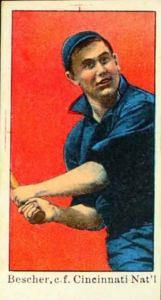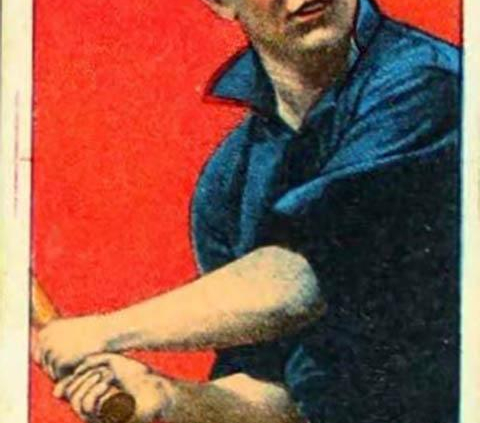Bob Bescher
 Bob Bescher amassed 428 career stolen bases even though he played regularly for only eight seasons in the major leagues. The switch-hitting leadoff hitter and left fielder pilfered 81 bases in 1911, still the Cincinnati Reds single-season record. In 1912 F.C. Lane of Baseball Magazine declared him the “King of Basestealers,” not only for his raw number of steals but for his steals gathered per hit, which outshone the likes of Ty Cobb and other luminaries. Bescher studied National League pitchers to help him get a good jump and always slid feet first, eluding the tag by employing a tremendous hook slide. Judging the height of the catcher’s throw by the infielder’s hands, Bescher would slide to the inside part of the bag if the throw was high and to the outside if it was low.
Bob Bescher amassed 428 career stolen bases even though he played regularly for only eight seasons in the major leagues. The switch-hitting leadoff hitter and left fielder pilfered 81 bases in 1911, still the Cincinnati Reds single-season record. In 1912 F.C. Lane of Baseball Magazine declared him the “King of Basestealers,” not only for his raw number of steals but for his steals gathered per hit, which outshone the likes of Ty Cobb and other luminaries. Bescher studied National League pitchers to help him get a good jump and always slid feet first, eluding the tag by employing a tremendous hook slide. Judging the height of the catcher’s throw by the infielder’s hands, Bescher would slide to the inside part of the bag if the throw was high and to the outside if it was low.
Robert Henry Bescher was born on February 25, 1884, in London, Ohio, 25 miles southwest of Columbus. His parents, Antone and Mary Bescher, with whom he lived on the outskirts of London for much of his life, were owners of a local brick factory. A brother and sister died young, leaving Bob as an only child. At age 15 he left home to attend Notre Dame, which until World War I enrolled students from first grade through graduate school. Bob prepped under the Golden Dome from 1899 to 1902, playing no varsity sports even though his status as a high-school student would not have prevented him from doing so. He then spent a year punching cows at a Nebraska cattle ranch. While there Bob developed skills that he employed years later while spending off-seasons at his manager Clark Griffith‘s ranch in Montana.
In 1904 Bescher returned to Ohio to attend Wittenberg College in Springfield, less than 20 miles from his hometown of London. In his two-year college career he used his speed and size—6’1″ and about 200 lbs.—to great advantage on the gridiron, garnering all-state honors as a halfback and becoming the greatest football player in early Wittenberg history. In later years Bescher went on to don the leather helmet professionally for the Dayton Oakwoods, playing even during the baseball season under an assumed name. Bob claimed he was never injured playing football—but baseball was another story. In 1907 he suffered a broken leg sliding into first on a close play, and three years later he mangled his hand on the sharp edges of the box seats while attempting to catch a foul ball. Emergency surgery prevented his hand from being reduced to a claw.
Bescher signed his first professional baseball contract in 1906 with Lima, Ohio, of the Class C Interstate Association, batting a remarkable .539 in 39 games before the league folded in July. He finished the season with the nearby Class B Central League team in Dayton, where he remained during his injury-plagued 1907 campaign. In Bescher’s third season in Dayton he batted .305 and swiped 62 bases. The Cincinnati Reds took notice and bought his contract for $1,800. On September 5, 1908, Bob made his major league debut in Cincinnati, hitting a triple and scoring a run in a 6-5 victory over St. Louis.
Bob Bescher gained immediate stardom as one of the NL’s premier baserunners, leading the league in stolen bases for four consecutive seasons, 1909-12. “The London Flash”—one of several nicknames given him by newspaper reporters—enjoyed his best season on the basepaths in 1911, when he drew 102 bases on balls en route to a career-high on-base percentage of .385. That year Bescher established modern NL record of 81 steals (breaking his own record of 70 set the previous year), a mark that stood for more than a half-century until Maury Wills swiped 104 in 1962. Even more remarkable, he was thrown out stealing only three times the entire season.
But “The Speeder,” to use another of his newspaper nicknames, actually got off to a rough start in 1911. After a contentious tie game on April 18 he was involved in a well-publicized row with Roger Bresnahan, sending the St. Louis Cardinals player-manager to the dentist’s chair after landing a solid punch on his “well-developed word machine.” (Though generally reserved and good-natured, Bescher could react violently when provoked; on another occasion he beat up a fellow player for throwing a bat at a friend’s dog that ran onto the field during practice.) By the end of May he had stolen a total of only 10 bases, but a spurt of 11 during the first five days of June put him on course for the record.
To understand Bescher’s style of play, consider his performance against the Phillies on August 6, 1911. Early in the game he stole home on a straight double-steal after stretching what should have been a routine single into a double. In the eighth inning Bescher was on first base when a teammate laid down a sacrifice bunt. Phillies second baseman Otto Knabe fielded a low throw to first behind the bag and focused his attention on preventing the batter from advancing. Meanwhile, Bescher never stopped running, and the warning cries from Knabe’s teammates came too late—Bescher scored before the ball reached home.
In 1912 Bescher batted a career-high .281 and finished fifth in the voting for the Chalmers Award, leading the NL with 120 runs scored and posting an exceptional 87% success rate in his stolen-base attempts. But towards the end of the 1913 season he began to show signs of slowing up. In his last 50 games Bescher was only 13 for 23 (57%) in stolen-base attempts and also grounded into seven double plays. Though his 94 walks led the NL, his 38 stolen bases ranked sixth, well behind Max Carey, the new “King of Basestealers.” On December 12, 1913, the Reds traded Bescher to the New York Giants for Buck Herzog and Grover Hartley.
In 1914 “The London Flash” batted .270 and played center field for the first time in his career, but his difficulty getting along with John McGraw caused him to move on to the St. Louis Cardinals after only one year with the Giants. In three seasons in St. Louis his batting average fell from .263 to .235 to .155. Bescher wound up his major league career by appearing in 25 games with Cleveland in 1918, then bounced around the minor leagues for several years before retiring from baseball at age 41.
In retirement Bescher returned to London and worked as an oil inspector for the state of Ohio, mixing in frequent hunting and fishing trips. He also managed the Eagles Lodge, earning a reputation during Prohibition as a talented manufacturer of home brew. Bescher remained a local legend; a London storefront displayed pictures of him and Ty Cobb, the NL and AL single-season record holders in stolen bases. Bob kept in touch with his Cincinnati roots, contacting the Reds now and then to recommend a player or express interest in a coaching position (which never materialized).
Bob Bescher died prematurely on November 29, 1942, two miles west of the town where he was born, when a train slammed into the car he was driving, also killing a female passenger.
Note: An earlier version of this biography appeared in Tom Simon, ed., Deadball Stars of the National League (Washington, D.C.: Brassey’s, Inc., 2004).
Sources
National Baseball Hall of Fame Library. Bob Bescher file.
Bass, Mike. “Deion in pursuit of little-known Bescher.” Cincinnati Post [online edition], August 5, 1997.
“Bescher’s Work in Two Seasons.” Baseball Magazine (Vol. 11, Issue 6), October 1913, p. 77.
Lane, F. C. “The King of the Basestealers.” Baseball Magazine (Vol. 9, Issue 4), August 1912, p. 31-38.
“Short Lengths.” Baseball Magazine (Vol. 12, Issue 6), April 1914, p. 69.
“A Stolen Base that was Found.” Article in Cincinnati Reds Scrapbook, p. 42-43. Virginia Beach, VA: J. C. P. Corp. of Virginia, 1982.
“Who’s Who on the Diamond.” Baseball Magazine (Vol. 3, Issue 5), September 1909, p.67.
www.baseballlibrary.com
www.baseballreference.com
Full Name
Robert Henry Bescher
Born
February 25, 1884 at London, OH (USA)
Died
November 29, 1942 at London, OH (USA)
If you can help us improve this player’s biography, contact us.


